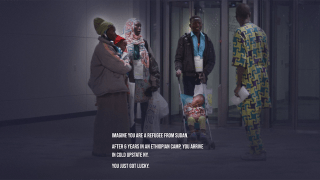
Screening of Utica: The Last Refuge. Directed by Loch Phillips
Utica: The Last Refuge opens with the Azeins, a refugee family of four from Sudan, arriving at Syracuse International Airport. After spending six years in a camp in Ethiopia, they have finally made it to the US, where they are welcomed by Abdelshakour, a fellow refugee from Sudan. An employee of Utica’s venerable refugee resettlement agency, he sees that they have few belongings so he gives them the winter coats he has brought with him. Nada is pregnant. They will soon be a family of five and need extra attention because they have no relatives in the area.
That the Azeins have arrived in the midst of unprecedented upheaval in US policies towards refugees adds a layer of additional tension to their story. The adjustments refugees, especially those from remote rural areas, have to make to survive here are considerable. The Mohawk Valley Resource Center for Refugees (MVRCR) is regarded nationally as a model agency for how refugee resettlement is done, for how they guide Utica’s refugees into comfortable jobs and lives, but they are suddenly facing new stresses. Reduced incoming numbers means a reduced budget. If their ability to assist the Azeins is compromised, their journey here becomes that much more difficult.
The typical ups and downs of the Azeins' story of acclimation is softened by Utica itself. A small city rebounding after its population fell from a high of nearly 110,000 in the 1960s to a low of about 60,000, Utica is building its recovery around refugees. While the population is still only about 62,000, nearly 20% are now refugees and their children. Local politicians, from the Mayor on down, extol the virtues of Utica’s diversity. The refugees, they say, are hardworking and dedicated. As of 2017, industry was returning to the area. With President Trump’s inauguration that year, refugee resettlement policy changed dramatically.
Questions abound. Will Utica’s economic turnaround be slowed by a drop in incoming refugees? As refugee resettlement agencies across the country are forced to close their doors, will MVRCR survive? Will the Azeins find a way to support themselves? While much media attention is focused on where refugees first land, on beaches and in camps, Utica: The Last Refuge looks at why the future is so bleak for most refugees: the system is backed up.
